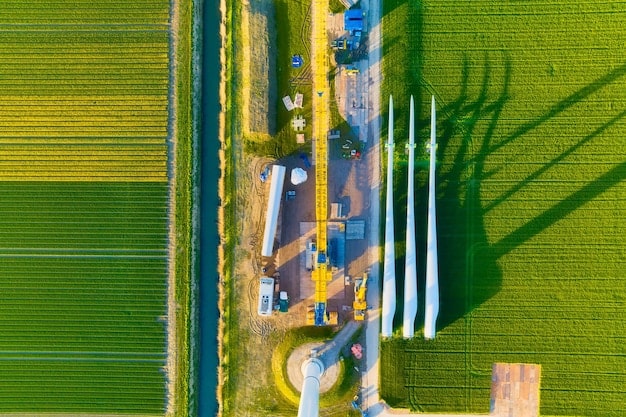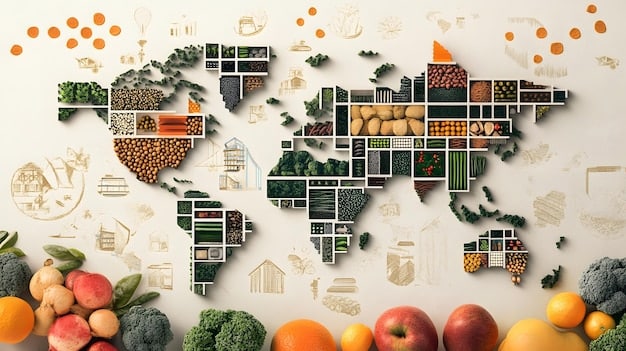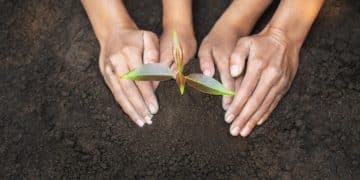Unforeseen Consequences: Sustainable Agriculture’s Impact on US Food Supply

The shift towards sustainable agriculture in the US is poised to reshape the food supply chain, bringing forth both anticipated benefits and complex, often unforeseen, consequences that demand meticulous evaluation for long-term resilience and equitable outcomes.
The transition to sustainable agriculture marks a pivotal moment for the US food supply. As we delve into Insider Knowledge: The Unforeseen Consequences of the Shift to Sustainable Agriculture in the US Food Supply Chain, it becomes clear that this evolution is far more intricate than often portrayed, carrying implications that extend beyond immediate environmental benefits.
The Grand Premise: Driving Forces Behind the Shift
The call for sustainable agriculture has grown into a powerful anthem across the United States. Driven by environmental concerns, changing consumer preferences, and a growing recognition of industrial farming’s long-term costs, this shift is no longer a niche pursuit but a mainstream imperative.
Concerns over soil degradation, water scarcity, chemical runoff, and biodiversity loss have pushed policymakers, farmers, and consumers alike to seek more harmonious agricultural models. The promise is a food system that is regenerative, resilient, and equitable.
A significant factor is the increasing awareness among consumers about where their food comes from and how it’s produced. This demand for transparency and ethical sourcing has created a market pull for sustainably grown products, influencing large corporations and small farmers alike.
Beyond the environmental narrative, there’s an economic argument forming. The rising costs of synthetic inputs, coupled with the long-term decline in soil fertility, suggest that current conventional practices may not be economically sustainable either. This economic pressure is causing a reevaluation of traditional farming methods.
Policy and Public Pressure
Government incentives and regulations are increasingly nudging the agricultural sector towards sustainable practices. Programs supporting organic certification, conservation easements, and soil health initiatives are becoming more prevalent, offering financial pathways for farmers to transition.
Public health concerns also play a role. Debates around pesticide residues, antibiotic resistance in livestock, and the nutritional density of conventionally grown foods contribute to the momentum. Consumers are opting for safer, healthier food options.
- Increased consumer demand for organic and local produce.
- Growing scientific consensus on climate change impacts on agriculture.
- Policy frameworks incentivizing soil health and biodiversity.
The cumulative effect of these forces is a profound transformation. What started as a fringe movement is now reshaping the very foundations of the American food system, with far-reaching implications for farmers, distributors, retailers, and every dinner table across the nation.
Infrastructure Strain and Logistical Hurdles
One of the most immediate, yet often underestimated, consequences of the shift to sustainable agriculture is the immense strain it places on existing infrastructure. Our current food supply chain is optimized for large-scale, centralized production and distribution.
Sustainable agriculture, particularly diversified and localized models, often operates on a smaller scale, requiring different transportation, storage, and processing facilities. This mismatch creates significant logistical hurdles that impede a seamless transition.
Consider the processing plants. Many large-scale processing facilities are designed for uniform, high-volume inputs from conventional farms. Sustainable farms, with their varied produce and often staggered harvest times, struggle to fit into these industrial pipelines.
The emphasis on local food systems, a cornerstone of sustainability, exacerbates this. While beneficial for freshness and reduced carbon footprint, it necessitates a robust network of regional aggregation points, smaller distribution centers, and direct-to-consumer channels that are currently underdeveloped.
Transportation and Storage Challenges
Conventional agriculture relies on a few large transport hubs and cold storage facilities. Sustainable models, with their decentralized nature, require a finer-grained network, from refrigerated vans for farm-to-table deliveries to smaller, multi-product storage solutions.
The cost of building out this new infrastructure is substantial. It requires investment in rural areas, often in communities lacking the initial capital or expertise. This gap can lead to bottlenecks, higher transportation costs, and ultimately, higher consumer prices for sustainable goods.
- Lack of localized processing facilities suitable for diverse produce.
- Inadequate regional distribution networks for smaller-scale farms.
- High capital investment required for new sustainable infrastructure.
Without significant investment and strategic planning, the infrastructure deficit could well become the primary bottleneck, limiting the scalability of sustainable practices and slowing down the transition, despite growing demand and environmental urgency.

Economic Repercussions: Cost, Access, and Farmer Resilience
The economic ramifications of sustainable agriculture are multifaceted, extending from production costs to consumer affordability and farmer livelihoods. While proponents highlight long-term savings and increased resilience, the initial transition often presents significant financial challenges.
Sustainable practices, such as organic certification or extensive rotational grazing, can be more labor-intensive and yield smaller immediate harvests compared to industrial monoculture. This often translates to higher production costs per unit.
For consumers, this translates into higher prices at the grocery store. While some segments of the population are willing and able to pay a premium for sustainably produced food, a significant portion of the US population, especially low-income communities, may find it inaccessible.
This raises critical questions about food equity and justice. If sustainable food becomes an exclusive luxury, it perpetuates disparities in health and environmental impact, undermining the very principles of broad sustainability.
Farmer Transition and Risk
Farmers face considerable risk during the transition period. Shifting from conventional to sustainable methods typically involves a significant learning curve, new equipment, and a multi-year period where yields may be lower as soil health and ecological balance are restored.
Access to capital and adequate support programs for these transitional years are crucial. Without them, smaller farms, often those most willing to adopt sustainable practices, could face bankruptcy. This could ironically lead to further consolidation in the agricultural sector, counteracting decentralization goals.
The market dynamics also shift. Sustainable farmers often rely on direct-to-consumer sales, farmers’ markets, or niche wholesale arrangements. These channels require different marketing and business skills than selling to large commodity buyers, posing another learning curve.
- Higher production costs for sustainable farming methods.
- Increased food prices for consumers, affecting affordability.
- Financial risk and learning curve for farmers during transition.
Ultimately, the long-term economic viability hinges on establishing robust markets for sustainable products, developing effective support systems for transitioning farmers, and addressing the equity challenges inherent in a higher-cost food system.
Regulatory and Certification Complexities
The move towards sustainable agriculture introduces a labyrinth of new regulations and certification processes. While intended to ensure genuine sustainable practices and build consumer trust, these complexities often create burdens for farmers and entire supply chains.
Defining “sustainable” itself is a challenge, leading to a proliferation of certifications: organic, biodynamic, regenerative, humane certified, no-till, carbon-neutral, and many more. Each has its own standards, audit processes, and often, associated fees.
For farmers, navigating this patchwork of certifications can be overwhelming and costly. Adhering to multiple sets of standards, undergoing numerous inspections, and maintaining detailed records divert resources from actual farming operations.
This complexity can also lead to consumer confusion. The average grocery shopper might struggle to differentiate between various labels, potentially leading to skepticism or reliance on a single, well-known marker like “organic,” even if other certifications offer equally valuable sustainable attributes.
Supply Chain Harmonization
The challenge extends beyond the farm gate. Processors, distributors, and retailers must also adapt to these diverse standards. Ensuring traceability from farm to fork becomes exponentially more complex when dealing with myriad different agricultural practices and certifications.
Harmonizing these disparate standards and streamlining certification processes is essential for scalability. Without it, the administrative burden might discourage mass adoption of sustainable practices, limiting their overall impact.
- Multiplicity of sustainable certifications creates confusion.
- High compliance costs and administrative burden for farmers.
- Challenges in supply chain traceability for diverse standards.
A strategic approach to regulation is required, one that supports genuine sustainability without inadvertently creating barriers to entry or unnecessary bureaucratic hurdles for those striving to implement better practices.
Technological Adoption and Digital Divide
Technology plays a crucial role in the future of sustainable agriculture, yet its adoption faces challenges, particularly related to the digital divide within rural America. Precision agriculture, data analytics, and IoT sensors can optimize resource use, but only if widely accessible.
Modern sustainable farming often relies on sophisticated tools for monitoring soil health, managing water use, and tracking crop rotations. These technologies require reliable internet access, which is still a major issue in many agricultural regions of the US.
The digital divide isn’t just about internet connectivity; it also encompasses access to suitable devices, digital literacy, and the financial capacity to invest in new agricultural technologies. Smaller, less capitalized farms often fall behind in this technological race.
This creates a disparity where larger, more technologically advanced farms might more easily achieve sustainable efficiencies, potentially leaving smaller farms at a disadvantage or unable to fully optimize their resource use.
Innovation vs. Tradition
There’s also a cultural aspect. While many farmers are open to innovation, traditional farming communities might be hesitant to adopt new technologies without clear demonstrations of their long-term benefits and ease of integration into existing practices.
Bridging this gap requires targeted educational programs, accessible technology solutions, and subsidies to help farmers make the necessary investments. Without it, the full potential of tech-enabled sustainable agriculture won’t be realized nationwide.
- Rural digital divide limits access to essential agricultural tech.
- Cost barriers to adopting precision farming tools.
- Need for education and support to integrate new technologies.
Ensuring equitable access to technology and fostering digital literacy among all farmers is paramount. This will allow the benefits of sustainable agriculture to be distributed more broadly, making the entire food supply chain more efficient and resilient.

Market Dynamics and Consumer Behavior Shifts
The shift to sustainable agriculture fundamentally alters market dynamics, impacting everything from product availability to pricing structures. Consumer behavior, while a driving force, also presents its own set of unpredictable variables.
As more farms convert to sustainable practices, the supply of conventionally grown commodities may decrease, causing price fluctuations. Conversely, an increased supply of sustainable goods could eventually drive down their premium prices, making them more competitive.
Consumer preferences are not monolithic. While a growing segment prioritizes sustainability, factors like convenience, brand loyalty, and habit remain powerful. The availability gap for certain sustainable products, or their higher cost, can deter widespread adoption.
Educating consumers about the true value and benefits of sustainable food—beyond marketing buzzwords—is critical. Without a deeper understanding, the market for these products might not grow fast enough to support the widespread agricultural transition.
Retailer Adaptation and Supply Chain Flexibility
Retailers play a crucial intermediary role. They must adapt their sourcing strategies to accommodate smaller, more diverse suppliers and communicate the value proposition of sustainable products effectively to their customer base.
The current retail landscape favors large-scale, consistent supply. Sustainable agriculture, with its inherent seasonality and variability, challenges this model. Retailers need to build more flexible and localized supply chain partnerships.
- Fluctuations in supply and price for both conventional and sustainable goods.
- Varied consumer preferences impacting market growth for sustainable options.
- Retailer need to adapt sourcing and marketing for sustainable products.
Understanding and proactively managing these market and behavioral shifts will be vital for a successful transition. It requires collaboration across the entire food value chain, from producers to consumers, to align incentives and outcomes.
Resilience, Adaptation, and The Path Forward
The shift to sustainable agriculture is not merely a change in farming methods; it is a fundamental re-evaluation of our relationship with food, land, and community. The unforeseen consequences discussed are not roadblocks but critical points for conscious adaptation.
True sustainability integrates ecological health with economic viability and social equity. Addressing the infrastructure deficit, supporting farmer transitions, streamlining regulations, bridging the digital divide, and understanding market dynamics are all interconnected challenges.
The food supply chain of the future will be more decentralized, resilient, and responsive to local conditions and global environmental changes. This requires significant investment, not just financial, but in terms of knowledge sharing, innovation, and policy alignment.
Building a resilient US food supply chain means fostering diverse agricultural systems, empowering farmers with resources and knowledge, and creating accessible markets for sustainably produced food for all citizens. It’s an ongoing journey of learning and adaptation.
The collective wisdom of farmers, scientists, policymakers, and consumers will be essential in navigating these complexities. The unforeseen consequences are opportunities for collective problem-solving, leading to a food system that serves both people and planet more effectively.
| Key Aspect | Brief Description |
|---|---|
| 🏗️ Infrastructure Strain | Existing supply chain optimized for industrial scale, hindering localized sustainable models. |
| 💰 Economic Impact | Higher production costs, consumer prices, and financial risks for transitioning farmers. |
| 📜 Regulatory Complexity | Myriad certifications and regulations create burdens for farmers and supply chain management. |
| 💡 Tech Adoption Gaps | Digital divide and cost limit widespread adoption of efficiency-boosting technologies. |
Frequently Asked Questions About Sustainable Agriculture Shift
The main drivers include growing environmental concerns over conventional farming’s impact, evolving consumer demand for healthier and ethically produced food, and increasing awareness of the long-term economic unsustainability of chemical-dependent agricultural practices. Policy incentives and public health debates also play a significant role in accelerating this transition.
Initially, sustainable agriculture can lead to higher consumer prices due to increased labor, certification costs, and potentially lower yields during the transition phase for farmers. However, as practices scale and infrastructure adapts, these premiums may decrease, making sustainably produced food more accessible over time. Subsidies can also influence affordability.
Farmers face significant challenges including the financial burden of new equipment, the learning curve for different farming techniques, a potential reduction in yields during the initial years, and navigating complex certification requirements. Access to capital and appropriate support programs are crucial for mitigating these risks and ensuring a successful transition.
The digital divide severely limits the adoption of advanced sustainable farming technologies like precision agriculture and IoT sensors, which rely on reliable internet access. This disproportionately affects rural areas and smaller farms, hindering their ability to optimize resource use and achieve full sustainability potential. Bridging this gap is essential for equitable progress.
Retailers are pivotal in connecting sustainable producers with consumers. They must adapt their sourcing strategies to accommodate diverse, often smaller, suppliers and build more flexible, localized supply chains. Additionally, effective communication of the value and benefits of sustainable products to customers is crucial for driving market demand and supporting the agricultural transition.
Conclusion: Cultivating a Resilient Future
The discourse around Insider Knowledge: The Unforeseen Consequences of the Shift to Sustainable Agriculture in the US Food Supply Chain reveals a complex yet ultimately necessary transformation. While the path is fraught with challenges—from logistical bottlenecks and economic hurdles to regulatory complexities and technological disparities—these are not insurmountable. They are the intricate knots of a system undergoing profound change, each requiring a thoughtful, collaborative unraveling. By prioritizing investment in infrastructure, providing robust support for farmers, streamlining certification processes, bridging the digital divide, and fostering informed market dynamics, the US can move towards a food system that is not only environmentally sound but also economically just and socially equitable for generations to come. This transition is less about radical upheaval and more about intelligent evolution, guided by collective experience and a shared vision for resilience.





